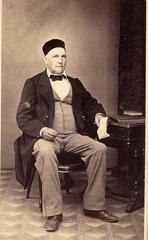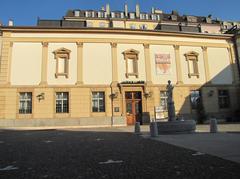
Ethnographic Museum of Neuchâtel: Comprehensive Visiting Guide for 2025
Date: 04/07/2025
Introduction
Nestled in the heart of Neuchâtel, Switzerland, the Ethnographic Museum of Neuchâtel (Musée d’ethnographie de Neuchâtel, MEN) stands as a pioneering institution at the crossroads of cultural heritage and innovative museology. Since its inauguration in 1904 within the historic Villa de Pury, the MEN has evolved into an international reference for critical ethnography, housing over 50,000 artifacts from around the globe, with a particular emphasis on African collections. More than a repository, the museum challenges traditional narratives, inviting visitors to interrogate the very processes of collecting, exhibiting, and interpreting cultural heritage (whichmuseum.com; men.ch; Wikipedia).
This guide provides a detailed overview of the museum’s history, architectural evolution, exhibition philosophy, practical visitor information—including visiting hours, tickets, and accessibility—and expert tips for making the most of your visit to one of Switzerland’s most engaging cultural destinations.
Table of Contents
- Introduction
- History and Origins
- Architectural Evolution: Villa de Pury and Modern Extensions
- Exhibitions: Permanent, Temporary, and Outdoor Installations
- Practical Visitor Information: Opening Hours, Tickets, and Accessibility
- Tips for Visitors and Highlights
- Frequently Asked Questions (FAQ)
- Digital Resources and Engagement
- Related Attractions in Neuchâtel
- Summary & Recommendations
- References
History and Origins
The MEN traces its roots to the late 18th century, when General Charles Daniel de Meuron began collecting natural history specimens and ethnographic objects. These early collections embodied Enlightenment curiosity and a global outlook. In 1902, philanthropist James-Ferdinand de Pury bequeathed his villa on Saint-Nicolas hill to the city, stipulating its transformation into an ethnographic museum. The museum officially opened its doors on July 14, 1904, in a setting designed by architect Léo Châtelain, blending neoclassical elegance with local heritage (Wikipedia).
Architectural Evolution: Villa de Pury and Modern Extensions
Villa de Pury
The Villa de Pury, perched above the city in a landscaped park, is the architectural heart of the MEN. The villa’s original design by Léo Châtelain reflects late 19th-century tastes and has been carefully adapted for museum use, balancing historic preservation with contemporary exhibition needs (men.ch).
Expansions and Renovations
As the museum’s collections grew—now numbering approximately 50,000 objects—the MEN expanded through several building phases:
- Early 20th Century: Annexes and adapted rooms to accommodate new acquisitions.
- Mid-Late 20th Century: Introduction of climate controls, improved lighting, and security; flexible galleries to support critical and experimental displays.
- 21st Century Renovation (2015–2020): Comprehensive upgrades restored the villa, added modern spaces for temporary shows, research, and education, and enhanced accessibility. The result is a harmonious blend of historical ambiance and state-of-the-art museology (Wikipedia; men.ch).
The museum’s landscaped park extends the experience outdoors, hosting installations that encourage reflection on the relationship between humans and their environment (beaulac.ch).
Exhibitions: Permanent, Temporary, and Outdoor Installations
Permanent Exhibition: “The Impermanence of Things”
The museum’s reference exhibition, “L’impermanence des choses” (“The Impermanence of Things”), offers thought-provoking perspectives on ethnology, emphasizing the shifting meanings of cultural objects and the evolving nature of museum collections (men.ch).
Temporary and Thematic Exhibitions
MEN is renowned for dynamic temporary exhibitions that question contemporary issues and museological practices. Notable recent projects include:
- “Cargo Cults Unlimited” (until January 18, 2026): This immersive exhibition explores global commerce by recreating a port environment with shipping containers, prompting visitors to examine the narratives of trade and “cargo cults” in both historical and modern contexts (BLS Museum Guide).
- “Return from Angola”: An exhibition dissecting the museum’s own collecting practices and the ethics of ownership, using immersive environments to engage with the legacy of Swiss expeditions (journals.openedition.org).
Outdoor and Park Installations
The surrounding park serves as a venue for outdoor exhibitions, such as “Grandeur Nature” (“Life-Size”), which invite contemplation of human-environment relations (beaulac.ch).
Practical Visitor Information: Opening Hours, Tickets, and Accessibility
- Location: 4, rue Saint-Nicolas, 2000 Neuchâtel, Switzerland (myswitzerland.com).
- Opening Hours: Tuesday–Sunday, 10:00–17:00. Closed Mondays and public holidays. Always confirm on the official website.
- Tickets:
- Adults: CHF 8–12 (varies by exhibition)
- Reduced (students/seniors): CHF 4–8
- Children under 18: Free
- Free entry on Wednesdays
- Discounts for holders of the Neuchâtel Tourist Card (travelonatimebudget.co.uk)
- Booking: Tickets are available onsite and online. Group tours and educational visits should be arranged in advance.
- Accessibility: The museum is generally accessible for visitors with reduced mobility, with ramps and elevators. Some historic areas may have limited access; contact [email protected] for details.
- Languages: Exhibition texts in French and English; guided tours available in French, English, and German.
Tips for Visitors and Highlights
- Allocate at least 2 hours to explore both permanent and temporary exhibitions.
- Take advantage of free Wi-Fi and download digital guides or virtual tours.
- The Villa de Pury’s architecture and landscaped park provide excellent photography opportunities.
- The museum shop offers unique gifts and ethnographic publications.
- Use your Neuchâtel Tourist Card for free museum entry and public transport.
- Plan your visit to coincide with special events, workshops, or temporary exhibitions—check the event calendar for details.
Frequently Asked Questions (FAQ)
Q: What are the museum’s opening hours?
A: Tuesday–Sunday, 10:00–17:00. Closed on Mondays and holidays.
Q: How much is admission?
A: CHF 8–12 for adults, CHF 4–8 for students/seniors, free for children under 18. Free on Wednesdays.
Q: Is the museum accessible for people with disabilities?
A: Yes, with ramps, elevators, and accessible restrooms. Contact the museum for specific needs.
Q: Are guided tours available?
A: Yes, in French, English, and German, by advance request.
Q: Can I take photographs inside?
A: Photography is permitted without flash or tripods. Some restrictions may apply in temporary exhibitions.
Q: How do I get to the museum?
A: A 10–15 minute walk from the train station or city center; accessible by bus. Limited parking is nearby (myswitzerland.com).
Digital Resources and Engagement
- Explore virtual tours, high-quality images, and exhibition previews on the official MEN website.
- Download the trilingual brochure for “Cargo Cults Unlimited” and other digital materials.
- Follow MEN on social media for updates, behind-the-scenes content, and upcoming events.
Related Attractions in Neuchâtel
Enhance your cultural itinerary by visiting other Neuchâtel historical sites:
- Neuchâtel Castle: A medieval fortress overlooking the city.
- Laténium Archaeology Museum: Switzerland’s largest archaeological museum.
- Lake Neuchâtel Promenade: Scenic walks and leisure activities.
- Museum of Art and History: Fine arts and regional history (visitneuchatel.com).
Summary & Recommendations
The Ethnographic Museum of Neuchâtel is a landmark of Swiss cultural heritage and museological innovation. Its unique blend of historic architecture, critical exhibitions, and community engagement makes it an essential destination for anyone interested in ethnology, history, or contemporary debates on cultural heritage. With its accessible opening hours, affordable tickets, and strategic location, MEN offers a rich, thought-provoking experience for visitors of all backgrounds.
To maximize your visit:
- Review current exhibitions and events on the museum’s website.
- Download the Audiala app for guided tours and exclusive digital content.
- Take advantage of free admission offers and public transport with the Neuchâtel Tourist Card.
Experience a museum that not only preserves the past but also actively questions and shapes our understanding of cultural connections in a globalized world.
References
- whichmuseum.com
- Wikipedia
- men.ch
- Swiss Spectator
- journals.openedition.org
- BLS Museum Guide
- myswitzerland.com
- travelonatimebudget.co.uk
- beaulac.ch
Suggested visuals for your visit:
- Exterior of Villa de Pury: “Villa de Pury, home of the Ethnographic Museum of Neuchâtel”
- Immersive port installation from “Cargo Cults Unlimited”
- Map showing museum location and nearby historical sites




